Restoration Still Underway On PB4Y-2 Privateer
by ANN Warbird Correspondent Tom Griffith
It was during March of 2002 that I first met William D.
Jolliffe. I was on an early ANN assignment covering what might be
considered an "orphan" warbird: the Consolidated PB4Y-2
Privateer that had been (and still is) under
restoration at the Lone Star Flight Museum in Galveston, TX for
quite a while (15 years or so as this is written).

Bill Jolliffe, a LSFM volunteer who'd taken the big USN bomber
on as his "own" project, was given the duty to escort me under,
through and on top of the big USN bomber. He also had to answer
questions, a LOT of them, from yours truly. Bill knew "a little"
about the Privateer. Indeed, as a US Navy enlisted pilot in WWII,
he flew thousands of hours in Privateers similar to the one that
the LSFM is restoring.
In the dozen or so photos that follow, all but one, the last
one, were taken in 2002 when I first met Bill Jolliffe.
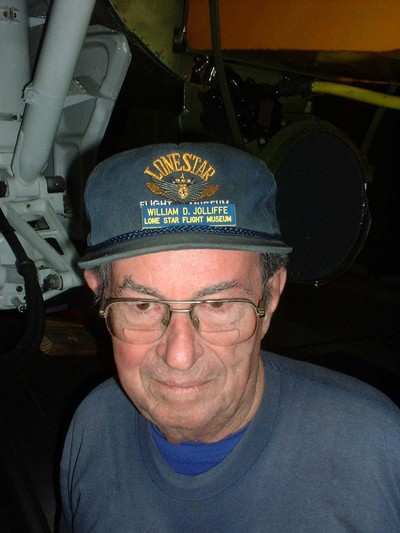
Above Bill's name badge are his USN wings. After I met Bill,
upon subsequent visits, at least yearly, I always hunted him up to
get updates on the Privateer and the Museum in general.
Bill was a genuine WWII combat veteran (I believe his USN career
lasted from 1939 to 1948) and that puts him right at the top of the
heap as far as mortal beings are concerned with me (with the
exception of my own family, but you know what I'm talking about!) I
have to say "was" because at the April airshow at Galveston, I
couldn't find my old friend and asked another LSFM staff member if
"Bill was around."
I was told that Bill had passed away earlier this year, February
23, actually. One knows that WWII veterans are dying at the rate of
over 1000 a day, or so I've heard... and on February 23, it was
Bill's turn. This little article will feature a few photos of Bill
and his beloved Privateer, seemingly a warbird that will take
several more years to become airworthy again.

Bill is demonstrating a characteristic of computing gunsights --
he is indicating with his eyes where a gunner would actually see
his target in a situation where his own aircraft is moving and the
target aircraft is also moving, but in a different direction and at
a different speed. The computing gunsight might be directing the
gunner to take aim at what seems to be the wrong place in order to
hit the moving target.
When I met up with Bill and the PB4Y-2 in 2002 to do the ANN
article, the aircraft was in its seemingly permanent spot on the
floor of the main hangar at the LSFM. It has easily the TALLEST
vertical tail of anything in the hangar. For those who are not
quite fans of this big warbird (at least not yet!), the PB4Y-2 is
basically a B-24 Liberator bomber with two noticeable differences
between it and the B-24: the B-24 has twin tails and the PB4Y-2 has
one TALL tail (the tip of its tail is 30 feet off the ground when
it's parked - that's about 10 feet taller than its hangar-mate, the
B-17-G Flying Fortress. It's even a couple feet taller than that of
our biggest WWII bomber, the B-29 Superfortress!), and it sports a
fuselage that is 7 feet, 2 inches longer than that of the B-24.
They both share the same beautiful wing, with its Davis airfoil.
The earlier model PB4Y-1s very closely resembled the B-24 from
which they were derived (albeit with non-turbocharged engines since
the USN versions wouldn't need to fly at the altitudes of the USAAF
B-24s in everyday operations), but with the Dash 2 model, that big
tail and longer fuselage came along. This particular PB4Y-2, and a
few others like it, had been (one still is, or was, depending upon
where you look it up) used as fire bombers in Arizona, and other
places in the western USA. The LSFM Privateer had been converted to
carry fire-fighting chemicals and had battled many blazes between
1959 (two years after being "demilled" by the USN, which changed
its designation in the 1950s to "P4Y-2") and 1991 (when the LSFM
acquired it).

Even though the Privateer is a big aircraft, the vertical tail
seems to be even a little too big when compared to the rest of the
aircraft. It's not evident from this photo, but take a look
at the last photo and you'll see what I'm talking about. The spiral
staircase in the background seems to have been installed
specifically to give Museum visitors a bird's eye view of the
Privateer's tail - no such luck…it leads to the LSFM's
library and offices on the third level of the Museum.
When Bill Jolliffe took me on my up-close-and-personal tour of
the Privateer, I got a very good look at the nuts-and-bolts of this
warbird. Bill knew that besides being a warbird correspondent and
photographer, that I, as a private pilot myself, would be
interested in a unique feature of the wing on the Liberator and
Privateer: the wing is basically one-piece from tip to tip, and
where it passes through the fuselage, it still has an airfoil
shape! Sure, the rivets are round-headed, not flush like those on
the part of the wing that is outside doing all of the lifting, but
the airfoil shape is apparent, if someone points it out to you.
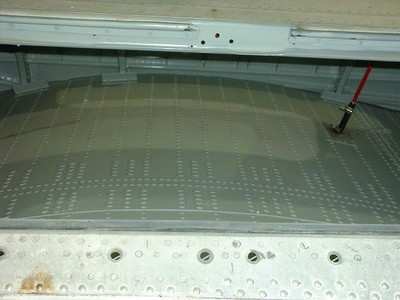
This photo was taken from the top of the left wing root. Through
the opening one can easily see the airfoil contour of the top of
the wing as it passes through the fuselage of the Privateer.
I was also impressed with the hundreds of feet of cable that go
from the controls (yoke and rudder pedals) to the control surfaces
(sure some of the control surfaces were not even on the aircraft
yet, but the cables were installed). I was surprised to see that
they seemed to be the same diameter of those on the little Cessna
150 that I had been part-owner in, once upon a time. I'd have
expected cables at LEAST twice as thick. The cables that actuate
the throttles, mixture, propellers and other engine/propeller
controls/accessories are even smaller! And, there seemed to be
dozens of them! Don't even get me started about the electrical
wiring! Paul Johnson, whom I met that same day in 2002, was busy
preparing wiring "runs" to be installed in the big bomber. That was
5 years ago and they still have more wiring to put into it, I
think.
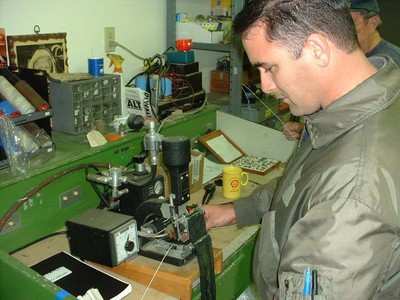
Paul Johnson is "stamping" a code on the plastic insulation on
otherwise plain white electrical wiring with a specialized "tool."
This handy little device uses its tiny 450 degree F branding iron
to brand a specific pattern (chosen by the operator, naturally)
onto individual wires. The operator pulls the entire length of wire
(it may be dozens of feet long) through the device and imprints the
brand onto the insulation every 15 inches, and the pattern that is
stamped on the wire is recorded in a notebook so they'll know which
pattern goes from what switch or controller to what light or other
electrical device. A number of virtually unlimited branding
patterns can be applied to wires using this simple method. Using
this marking method, a bundle of wires, all being the same color
and size, can be "read" by the electrician doing the wiring by
simply reading the brand on individual wires, and then hooking up
the electricals correctly without trial and error, AND, without
having to have a bazillion colors of insulated wires (to say
nothing about making it easier on color-blind folks, such as your
humble correspondent).
When I think about the complexity of even these "ancient"
aircraft, it amazes me that even ONE big aircraft a week, let alone
many each day, were produced during the War. Hats off to the men
and women who couldn't serve our country in the military during
WWII, and their employers, our wartime aviation industries. Thanks
to their concerted efforts, they filled the skies with over 100,000
aircraft in the WWII years -- we couldn't have won the War
without them.
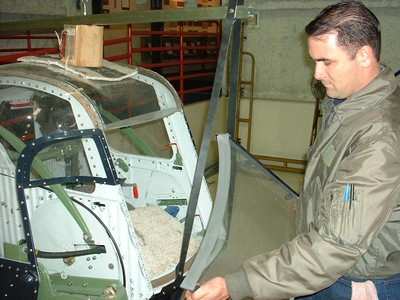
To maintain authenticity, the LSFM's Privateer has had power
turrets built to operational condition and installed in the big
bomber. As a fire-bomber, it had no turrets or gun positions and
the Museum had to either find surplus ones, and restore/rebuild
them, OR, start from scratch and build new ones. In this photo,
Paul Johnson is showing me the progress on the rear turret
restoration. He is holding a piece of 2-inch thick "armoured"
Plexiglas that helps to protect the gunner in this turret. The LSFM
restoration effort is very authentic - they could have used a
"thin" piece of regular Plexiglas, but they always strive for
accuracy in their restorations, so the special piece had to be made
for this particular installation. At the time of the photo, the
turret obviously was not installed, but I know that it has been in
place for a while now.

I had asked Bill about the enormous tires on the Privateer (I
learned that the Privateer's mains are the same as those on the
B-17 Flying Fortress) and he noticed something that looked "funny"
on the wheel, and discussed the problem with Paul. Paul is an
A&P/I technician, among other things, and between the two of
them, no squawk gets past them. This plane obviously came to the
Museum with a squawk list that looked something like the New York
City Yellow Pages, after the likes of Bill, Paul, et al were
finished looking her over. The big microphone-looking thing is the
oil cooler of engine No. 3 - I know that you thought Bill was
saying something into a big microphone like, "pay no attention to
that man behind the camera."
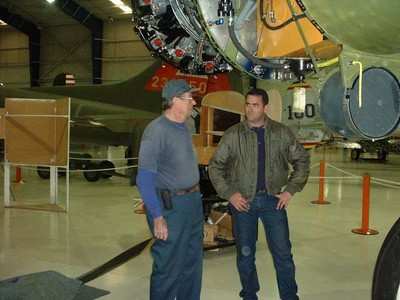
With engine No. 3 overhead (that's the oil cooler for the BIG
Wright R-2600 Double Cyclone radial engine in the far right of the
photo), Paul listens intently to the LSFM's authority on the
Privateer. Paul is also a pilot, and this, coupled with his A
&P/I credentials, has helped make the restoration get as far as
it has gotten.
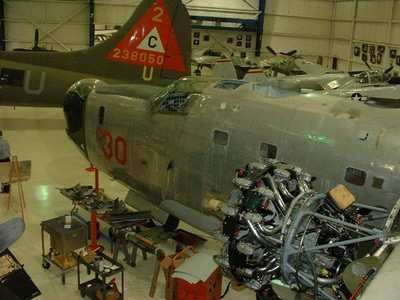
From my vantage point on the left wing, the No. 2 R-2600 engine
can be seen, as well as the front part of the Privateer's fuselage.
Nuts and bolts note: the original PB4Ys all had Pratt and Whitney
R-1830 engines on them, but the surplus ones used by the
fire-fighting companies converted them to power from Wright R-2600
engines that basically were QECs (Quick Engine Change units) from
B-25 Mitchells. The R-2600s that were intended to be installed in
the Mitchells were bolted onto the wings of the PB4Ys and instantly
added about 1,400 HP total to the airframe while adding only a few
hundred more pounds. They were nick-named "Super Privateers" by the
firm in Canyon, TX that did most of the conversions to the
ex-military Privateers. This greatly increased the gross weight
limits on the fire-bombers and enabled them to carry considerably
more water or other fire-fighting chemicals in their modified
"bomb-bays." By the way, that's the LSFM's B-17-G "Thunder Bird" in
the top left of the photo and on the opposite side of the photo we
see the P-38-L "Putt Putt Maru," which has since been sold (sad
note!)
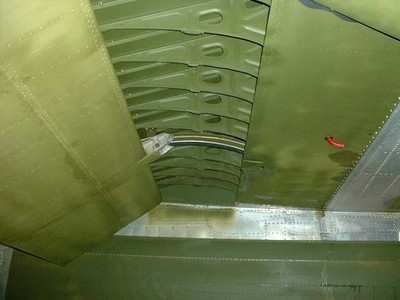
This photo shows the Fowler flaps of the Privateer. Fowler flaps
are operated by screw jacks and follow curved tracks out from the
trailing edge of the wings. Cessna 150s and other small Cessnas
also have Fowler flaps, so I at least recognized ONE feature of the
big bird.

Here we see your ANN reporter and Paul Johnson, posing on the
left wing of the Privateer. The funny little device attached to the
top of the wing in the lower left part of the photo is part of the
main fuel tank vent system.
All of the above photos were taken by me in 2002, and the final
photo was taken by me in April of this year. The big Consolidated
bomber hasn't changed a lot, visually, with the exception of the
power turrets and side guns being installed and nearly ready to go.
The engines seem to come and go - since the B-25 uses the same
engine, they've had to, shall we say, "borrow" and engine or two
from the Privateer to keep the B-25 flying.

This is the Consolidated PB4Y-2 Privateer in April 2007 (it's
looked basically like this for waaaay too long -- in honor of Bill
Jolliffe and the volunteers and other staff at LSFM, let's all get
behind this project and get her back into the air ASAP. Like the
song says, "all it takes is time and money.").
Speaking of the Lone Star Flight Museum and its staff, I
inquired at the Museum about just what volunteers mean to the
overall effort. Larry Gregory, the head honcho at LSFM, e-mailed
the following to me: "As a rule, we receive around 30-35,000
service hours a year from our volunteers. They are magnificent and
we couldn't keep the lights on much less fly anything without them.
They come from varied backgrounds and do incredible things for us."
Larry said it all in only three sentences!
One final word about Bill Jolliffe: he was an enlisted pilot, a
Chief Petty Officer, I believe. Enlisted pilots were pretty rare in
the US Navy. This gives Bill a unique perspective in his current
location. I'm sure that Bill, my dad, my uncles and my wife's
uncles are in heaven sharing "war stories" and trying to convince
the other guys just which branch of the service actually won the
War.
Blue skies and tailwinds be with you, my friend.
 ANN's Daily Aero-Linx (04.16.24)
ANN's Daily Aero-Linx (04.16.24) Aero-News: Quote of the Day (04.16.24)
Aero-News: Quote of the Day (04.16.24) Airborne 04.10.24: SnF24!, A50 Heritage Reveal, HeliCycle!, Montaer MC-01
Airborne 04.10.24: SnF24!, A50 Heritage Reveal, HeliCycle!, Montaer MC-01 Airborne 04.12.24: SnF24!, G100UL Is Here, Holy Micro, Plane Tags
Airborne 04.12.24: SnF24!, G100UL Is Here, Holy Micro, Plane Tags Airborne-Flight Training 04.17.24: Feds Need Controllers, Spirit Delay, Redbird
Airborne-Flight Training 04.17.24: Feds Need Controllers, Spirit Delay, Redbird














